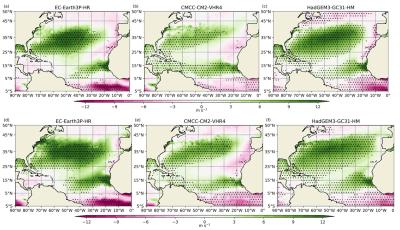The Relationship Between African Easterly Waves and Tropical Cyclones in Historical and Future Climates in the HighResMIP-PRIMAVERA Simulations
African easterly waves (AEWs) are disturbances that often serve as precursors for tropical cyclones (TCs) developing in the Atlantic Ocean. It is, therefore, important to understand the relationship between AEWs and TCs, and how this relationship may be affected by climate change. This research shows that future changes in the number of AEWs are not a good indicator of future changes in the number of TCs. AEW strength and a favorable environment, however, are good indicators for conditions that would lead to TC development in present and future climates.
TCs have the potential to be both deadly and destructive. Developing a better understanding of the factors that lead to TC development in present and future climates is crucially important for mitigating the effects of these extreme weather events. Although many factors contribute to the development of TCs, AEWs often serve as the initial disturbances required for these storms to form. In this study, we found that future changes in the number of AEWs were not a good indicator of future TC activity. This suggests that AEWs are not a limiting factor for future TC development.
In this study, we examine the relationship between AEWs and TCs in historical and future climates using three climate models from the HighResMIP PRIMAVERA simulations. AEWs and TCs were objectively tracked in the model data. To identify waves that developed into TCs, AEW and TC tracks were matched together if they were close to each other in space and time. The characteristics and frequency of AEWs and TCs in the historical and future climates were compared. We found that future changes in the frequency of AEWs are not a good indicator of future TC activity. However, AEW strength, as well as environmental conditions conducive to strong TCs, are good indicators of AEWs that develop into TCs in both historical and future climates.

